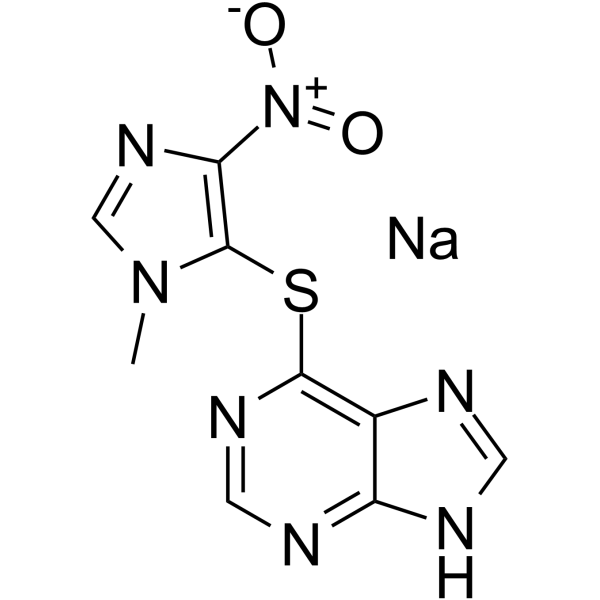Azathioprine Sodium
Modify Date: 2024-01-14 20:34:42

Azathioprine Sodium structure
|
Common Name | Azathioprine Sodium | ||
|---|---|---|---|---|
| CAS Number | 55774-33-9 | Molecular Weight | 299.244 | |
| Density | N/A | Boiling Point | N/A | |
| Molecular Formula | C9H6N7NaO2S | Melting Point | N/A | |
| MSDS | N/A | Flash Point | N/A | |
Use of Azathioprine SodiumAzathioprine (BW 57-322) sodium is an orally active immunosuppressive agent. Azathioprine can be converted in vivo to the active metabolite 6-mercaptopurine (6-MP). Azathioprine has myelosuppressive effects and induces apoptosis[1][3]. |
| Name | Azathioprine Sodium |
|---|---|
| Synonym | More Synonyms |
| Description | Azathioprine (BW 57-322) sodium is an orally active immunosuppressive agent. Azathioprine can be converted in vivo to the active metabolite 6-mercaptopurine (6-MP). Azathioprine has myelosuppressive effects and induces apoptosis[1][3]. |
|---|---|
| Related Catalog | |
| In Vitro | Azathioprine (0-50 μM, 48 hours) sodium can induce severe intracellular GSH depletion with relevant concentrations in both primary rat and human hepatocytes[2]. Cell Viability Assay[2] Cell Line: Rat hepatocytes, Human hepatocytes Concentration: 0-50 μM Incubation Time: 24-48 hours Result: Showed the decrease in cell viability and intracellular GSH levels in rat hepatocytes as low concentration of 0.5 μM but no significant decrease in cell viability at concentrations below 50 μM as well as GSH depletion was obviously noted at a concentration as low as 1 μM in human hepatocytes. |
| In Vivo | Azathioprine (oral gavage, 25–400 mg/kg, everyday, 10days) sodium can affect bone marrow cells, red blood cells, and peripheral blood cytokines and other related parameters in a dose-dependent manner, and can induce apoptosis in female CD-1 mice and ICR mice [3]. Animal Model: Outbred female CD-1 mice, Female ICR mice[3] Dosage: 25-400 mg/kg Administration: Oral gavage; everyday; 10days Result: Induced a decrease in erythrocyte-related parameters as well as leukocyte-related parameters in a dose-dependent manner. Induced 52.4%, 35.4%, 17.9%, 16.1% and 15.2% reduction in bone marrow cells at concentrations of 40, 60, 80, 100 and 120 mg/kg, respectively while fms-like tyrosine kinase-3(FLT-3) ligand (FL)-related cytokines were increased. Increased induction of apoptosis. |
| References |
| Molecular Formula | C9H6N7NaO2S |
|---|---|
| Molecular Weight | 299.244 |
| Exact Mass | 299.020142 |
| Sodium 6-[(1-methyl-4-nitro-1H-imidazol-5-yl)sulfanyl]purin-9-ide |
| 9H-Purine, 6-[(1-methyl-4-nitro-1H-imidazol-5-yl)thio]-, sodium salt (1:1) |
| Azathioprine Sodium |
| 7H-purine, 6-[(1-methyl-4-nitro-1H-imidazol-5-yl)thio]-, sodium salt |